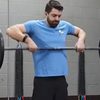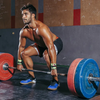Leg Press vs. Squat: Which Exercise Best Suits Your Fitness Goals?
For many gym enthusiasts, building strong and muscular legs is a key training goal, despite the occasional leg day skip by some. Squats and leg presses are two go-to exercises for targeting the lower body, but choosing between them can be confusing.
So, which exercise is more effective, or should you incorporate both into your routine? To help you decide, we’ll explore what both practical experience and scientific studies reveal about leg presses and squats. Get ready to dive into a comprehensive comparison to determine which exercise will best support your leg day objectives.
What Is a Leg Press?
The leg press is a machine-based exercise designed to target your lower body muscles. To do it, you sit on the machine with your back supported, usually at a 45-degree angle or flat. You then push a platform away from you with your feet, which engages your quadriceps, hamstrings, and glutes.

You can adjust the intensity of your workout by modifying the weight used. For a heavier load, increase the weight plates or adjust the weight stack. If you're looking for a lighter session, reduce the weight. This flexibility allows you to tailor the leg press to suit various fitness levels and goals, making it an effective choice for building leg strength and muscle.
What Is a Squat?
The squat is a compound exercise that works multiple muscle groups, including your quadriceps, hamstrings, glutes, and core. It’s excellent for building strength and muscle while engaging your entire core.
Different from leg press, performing a squat is in a standing position, then lower hips by bending your knees and pushing your hips back. Go down until your thighs are parallel to the floor or slightly below knee level.

You can do squats with various equipment or just your body weight. Options include using a barbell, one or two dumbbells, a kettlebell, or a resistance band. Each choice allows you to adjust the intensity and tailor the exercise to your fitness level and goals.
Mechanics and Muscles Targeted
How to Perform a Leg Press
- Set Up: Adjust the seat and backrest of the leg press machine so your knees align with the machine's pivot point when seated. Position your feet shoulder-width apart on the platform.
- Position Your Feet: Place your feet flat on the platform with your toes slightly pointed outward. Ensure your knees are bent and aligned with your toes.
- Begin the Exercise: Push the platform away by extending your legs, keeping your back flat against the backrest. Avoid locking your knees at the top.
- Lower the Platform: Slowly bend your knees to lower the platform towards your body, stopping when your thighs are parallel to the ground or slightly below.
- Repeat: Push the platform back to the starting position by fully extending your legs without locking your knees. Repeat for the desired number of repetitions.
Muscles Worked by the Leg Press
- Quadriceps
- Hamstrings
- Glutes
- Adductors
- Calves

How to Perform a Squat
- Set Up: Stand with your feet shoulder-width apart, toes slightly angled out. Keep your chest up and your back straight.
- Begin the Movement: Lower your body by bending your knees and pushing your hips back, as if you’re sitting back into a chair.
- Depth: Go down until your thighs are parallel to the ground or slightly below, ensuring your knees stay aligned with your toes.
- Return to Start: Push through your heels to straighten your legs and return to the starting position, fully extending your hips and knees.
- Repeat: Perform the movement for the desired number of repetitions.
Muscles Worked by the Squat
- Quadriceps
- Hamstrings
- Glutes
- Calves
- Core

Benefits of Leg Presses
- Isolation of Lower Body Muscles: Effectively targets the quadriceps, hamstrings, and glutes.
- Controlled Movement: Provides stability and reduces the risk of injury compared to free-weight exercises.
- Adjustable Intensity: Easily modify the weight to suit different fitness levels and goals.
- Reduced Lower Back Stress: Minimizes strain on the lower back, making it suitable for those with back issues.
- Improved Muscle Imbalance: Helps strengthen weaker leg muscles and correct imbalances.
- Enhanced Muscle Growth: Facilitates progressive overload, promoting increased muscle mass and strength.
Benefits of Squats
- Full-Body Engagement: Targets multiple muscle groups, including quadriceps, hamstrings, glutes, and core, promoting overall strength.
- Functional Strength: Mimics natural movements, improving real-life strength and stability.
- Core Activation: Significantly engages the core muscles, enhancing balance and core strength.
- Versatility: Can be performed with body weight, dumbbells, kettlebells, or barbells, offering varied intensity.
- Improves Athletic Performance: Boosts power and agility, benefiting various sports and activities.
- Increases Mobility: Enhances joint flexibility and functional mobility.
Drawbacks of Leg Presses
- Limited Functional Strength: Does not replicate real-life movements as effectively as free weights, potentially reducing functional strength benefits.
- Potential for Over-reliance: Overuse may lead to neglecting other essential lower body exercises and overall balance.
- Machine Dependency: Requires access to specific equipment, which may not be available in all gyms.
- Reduced Core Engagement: Less activation of the core muscles compared to compound exercises like squats.
- Less Functional for Athletes: May not be as effective for enhancing athletic performance and functional strength.
Drawbacks of Squats
- Technique Sensitive: Requires proper form to avoid injury, which can be challenging for beginners.
- Potential for Lower Back Strain: Incorrect form or excessive weight can strain the lower back.
- Knee Stress: Improper technique or heavy weights can place stress on the knees.
- Equipment Required: Heavy squats often require access to squat racks or barbells, which may not be available everywhere.
- Risk of Overtraining: Excessive squatting without proper recovery can lead to overtraining or muscle imbalances.
- Not Ideal for Beginners: Can be difficult for newcomers to master without adequate instruction.
Leg Press vs Squat: Major Differences
|
Aspect |
Leg Press |
Squat |
|
Equipment |
Performed on a leg press machine. |
Performed with body weight or free weights (e.g., barbell, dumbbells). |
|
Primary Focus |
Targets quadriceps, hamstrings, and glutes with a controlled movement. |
Engages quadriceps, hamstrings, glutes, and core with a full-body movement. |
|
Movement Pattern |
Pushes a platform away using the legs. |
Lowers the body by bending knees and hips, then returns to standing. |
|
Core Engagement |
Minimal core activation. |
Significant core engagement for stability. |
|
Lower Back Stress |
Lower back stress is minimal. |
Can place stress on the lower back if not performed with proper form. |
|
Range of Motion |
Typically limited to the range of the machine. |
Full range of motion, depending on flexibility and depth. |
|
Functional Strength |
Less functional for real-life movements. |
Mimics natural movements, enhancing functional strength. |
|
Customization |
Weight is adjusted via plates or a stack. |
Weight can be adjusted with various equipment (barbells, dumbbells). |
|
Learning Curve |
Generally easier to learn and perform. |
Requires proper technique to avoid injury and maximize effectiveness. |
|
Equipment Availability |
Typically available in most gyms with specific machines. |
Requires more versatile equipment; often more accessible. |
When and How to Use Each Exercise
Leg Press
When to Use:
Ideal for those focusing on isolating and building the lower body muscles, particularly when looking to minimize lower back strain. Great for individuals recovering from back injuries or seeking to enhance leg strength in a controlled environment.
How to Use:
- Warm-Up: Do a light warm-up.
- Setup: Adjust the seat and foot platform.
- Execution: Sit with your back supported, place your feet on the platform, and push away with your legs.
- Reps and Sets: Do 3-4 sets of 8-15 reps, adjusting the weight as needed.

Squat
When to Use:
Best for those looking to build overall functional strength and core stability. Essential for athletes and individuals who want to enhance their real-life movement efficiency and overall lower body strength.
How to Use:
- Warm-Up: Start with dynamic stretches.
- Setup: Stand with feet shoulder-width apart, with or without weights.
- Execution: Lower your body by bending at the knees and hips, then push back up.
- Reps and Sets: Do 3-4 sets of 6-12 reps, adjusting the weight to your fitness level.

Leg Press vs Squat: Comparative Analysis
Strength and Muscle Mass Development
Both exercises contribute to strength and muscle mass development, but squats offer a more comprehensive workout by engaging additional muscle groups, including the core. The leg press focuses on isolating the quadriceps, hamstrings, and glutes for targeted lower body growth.
Safety and Injury Prevention
The leg press provides a safer option for those concerned about balance or joint strain, as it offers more stability and support. In contrast, squats require careful attention to form to avoid injuries, particularly to the lower back and knees.
Versatility and Exercise Variety
Squats offer greater versatility with variations like front squats, overhead squats, and goblet squats, providing a range of benefits. The leg press is limited to the machine's design and focuses mainly on lower body strength.
Accessibility and Convenience
Leg presses require access to a specific machine, which may not always be available. In contrast, squats can be performed anywhere with minimal equipment, making them more accessible and convenient.
Conclusion
So, which will you choose for your next leg day: the leg press or the squat? If you’re after targeted muscle growth with a focus on safety, the leg press might be your best bet. But if you want to challenge your entire body and enjoy a versatile workout, squats are the way to go.
At RitKeep, we’re all about helping you maximize your workouts with top-notch equipment. Whether you’re pressing or squatting, we’ve got the gear to elevate your fitness game. Keep pushing, and let’s make every leg day count!
Frequently Asked Questions
Can I Perform Squats and Leg Presses on the Same Day?
Absolutely, you can perform squats and leg presses on the same day! Combining both exercises in your workout routine can provide a comprehensive lower body workout by targeting different muscle groups and movement patterns.
Which Exercise Is Safer?
When comparing safety between squats and leg presses, the leg press generally offers a safer option, especially for beginners or those concerned about joint strain, but squats can be performed safely with proper form and technique.
Can Leg Press Replace Squats?
While the leg press is a valuable addition to your leg workout routine, it doesn't replicate the full-body benefits of squats. Incorporating both exercises into your regimen can provide a more balanced and effective approach to lower body training.
Does Leg Press Work Glutes?
Yes, the leg press does work the glutes, especially when you position your feet higher on the platform or push through your heels during the exercise.
What happens if l do 100 squats everyday for 30 days?
Doing 100 squats every day for 30 days can enhance your lower body strength and muscle tone. However, it may also increase the risk of overuse injuries, so it's important to maintain proper form and allow for adequate rest.
Best Home Gym Gear in RitKeep
These are our most popular home gym machines — combining Smith Machine and Power Rack in one. Perfect for both guided and free weight training to support your everyday fitness goals.
PMAX 5600 All-In-One Smith Machine - Integrated Weight System
✔️ 6 IN 1 Gym Station
✔️ With 320 LB Weight Stack On Each Side
✔️ Feel the Burn Through 80+ Exercises
PMAX 4750 Dual Plate Loaded Multi Functional Smith Machine
✔️ Fuel Your Workout with 100+ Exercises
✔️ Dual Independent Pulley System
✔️ Removable Jammer Arms & Leg Extension
Destroyer M10 ALL-IN-ONE Home Gym Power Rack With Pulley System
✔️ Crossover Cable Pulley System
✔️ Heavy-Duty Multi-Functional Rack
✔️ Offering over 80+ exercises
-
Posted in
Barbell













